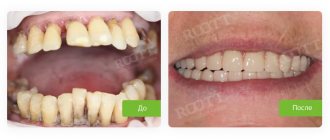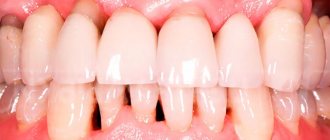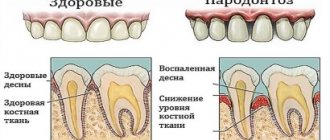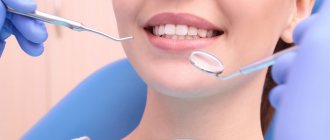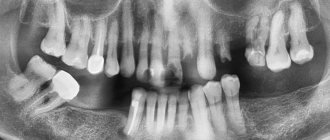Introduction
The information world is very huge. Each of us is haunted by a million points of view
for any problem in any field of knowledge, you just need to ask a search query. The same thing happens in medical circles on the Internet - discussions of health problems are widely represented by both patients and doctors and often reach the point of absurdity:
For example, in questions:
- loosening of the tooth,
- exposure of the neck of the tooth,
- why are my gums and teeth exposed?
that is, in situations where the gums on a tooth have receded, patients are always confused: they have periodontal disease
, then suddenly it changed to
periodontitis
, then periodontal disease returned again. And the search for an answer to the question becomes endless.
The problem of “how to treat periodontal disease” is picked up by doctors who only add fuel to the fire by recommending medications and even folk remedies for periodontal disease, without having sufficient competence to do so.
Let's consider these points of view professionally, and try to convey one simple truth, which for the vast majority of patients (and even some doctors) will be a revelation: the diagnosis of periodontal disease of the gums
» —
does not exist
.
An expert point of view is expressed by the famous periodontist, Doctor of Medical Sciences Laura Mikhailovna Tebloeva:
As a rule, for patients who come to me and say: “I have periodontal disease,” I always clarify - did you make this diagnosis yourself or did you see a doctor? Often patients answer that they have this information from their doctor. It turns out that the patient did not read somewhere and determine the diagnosis of “periodontal disease” for himself, but, unfortunately, such a diagnosis was made by a doctor.
Stages of periodontal disease
Periodontal disease can be acute or chronic. Depending on the degree of spread of the pathology, there are the following types of disease:
- localized - the necks of the teeth are exposed in a separate area;
- generalized - pathological processes develop throughout the dentition.
Periodontal disease develops over several years; depending on the patient’s condition, the disease is divided into stages:
- Early - the presence of initial changes in tissues, which can be determined by the dentist during examination;
- The first is increased sensitivity of teeth to hot and cold foods, receding gums;
- The second is pronounced exposure of the dental necks, sensitivity, the formation of gaps between the teeth and the appearance of dental cement instead of enamel;
- The third is severe receding gums, gradual loosening of teeth;
- The fourth is the advanced stage: the teeth become very loose, making it difficult to eat. At this stage, tooth loss occurs.
Always treat gum problems
When a patient comes to the doctor, he complains about something. What symptoms does he see a doctor with before receiving a diagnosis of periodontal disease? What worries him?
Literally, patients tell the doctor this: my gums have sagged, my gums have become exposed, my lower gums have receded. And for some reason the symptom of gum subsidence automatically means that the patient has the so-called. periodontal disease.
More experienced patients, who have already heard a lot of professional terms, who delve into the professional colloquial language of doctors, say this: “The necks of the teeth have become exposed a little, the teeth have become a little higher.” But, according to statistics, most patients complain about sagging gums.
And so, when patients come to the doctor with complaints about the problem of exposed tooth necks, the doctor diagnoses them with periodontal disease. Of course, he begins to treat them. And to treat it specifically for periodontal disease.
But time passes, money also goes away, and the question of why the gums recede and the necks of the teeth become exposed, why the gums recede, has not been resolved. And the patient still has periodontal disease.
What tactics are used to treat periodontal disease?
I want to start with the fact that patients who come with a diagnosis of periodontal disease, they need, every single one, treatment... not from the periodontist to whom they initially turned.
If we talk about the tactics of managing patients with the so-called. periodontal disease, which then come to me again, it’s a shame to voice this, but the treatment of periodontal disease was carried out right up to injections of Lincomycin into the exposed gum.
According to statistics, almost always the treatment of periodontal disease in adults with medications is burdened with a course of some antibiotics and physical therapy.
And most importantly, the task of all these manipulations is completely unclear: what do doctors want to achieve in this way, to destroy some kind of flora or to stop some destructive processes in the gums? It is very difficult for me to say what happens to the competence of a doctor who injects antibiotics for the so-called. periodontal disease, but this is absolute blasphemy. Is it possible to cure periodontal disease by destroying the flora? As a result, the gums will never recover.
Treatment of gum periodontal disease reaches the point of absurdity
I would like to note the widest range of drugs and folk remedies that patients use to attempt self-treatment of periodontal disease at home. Among the folk remedies, one can note the treatment of periodontal disease with hydrogen peroxide, and even treatment with soda:
What about the use of various toothpastes for periodontal disease? What goals do patients have? The purpose of toothpaste is preventative, not curative. And no toothpaste will eliminate inflammation, because there is no such inflammation in periodontal disease.
It is not difficult to guess that in these combinations of procedures the question of how to cure periodontal disease remains open.
Why does it appear
Periodontal disease is a chronic pathology that develops due to impaired blood supply to the gums. Most often, this disease occurs with age, the reason for this is a general deterioration in health, a slowdown in metabolic processes, and diseases of the cardiovascular system.
But periodontal disease can appear in young people, even children. This can happen due to poor oral hygiene, malocclusion or weak immunity. The cause is insufficient consumption of vegetables and fruits, large amounts of sweets and soft foods, smoking, hormonal imbalance, and long-term use of medications.
There is no inflammation with periodontal disease
When does the so-called periodontal disease, there is no inflammatory process in the gums. The clinical picture of “periodontal disease” differs sharply from periodontitis; it is with periodontitis of the tooth that inflammation occurs.
And injections into the gums, endless restorations of the necks of the gums - this is running in circles. Over time, again all the restoration fillings are chipped, and again these patients come to have these fillings restored again. And this happens endlessly
:
And the diagnosis of “periodontal disease” does not go away. As Desna ran away, she continues to leave. The fillings increase, that is, the teeth increase in size, because the gums sag more and more, and nothing useful happens.
When such a patient gets an appointment with me, unwinding his entire tangle of ordeals during the consultation, it becomes clear that all previously performed gum treatment consists of 3
factors:
- Lost time,
- lost money
- shattered hopes.
The diagnosis was incorrect and the treatment was appropriate for the incorrect diagnosis. What went wrong?
Patients should always go for a consultation with such a diagnosis... to an orthodontist
.
Because periodontal disease is an occlusal injury
.
What I see in these patients with signs of periodontal disease is a completely different diagnosis. This is an occlusal injury that can only be corrected by an orthodontist.
What are the signs of periodontitis?
The initial signs of periodontitis are bleeding gums when pressing on them or when brushing teeth, bluish or red gums, and bad breath. Already in the later stages of the disease, tooth mobility and visible exposure of their roots appear, which indicates a severe and advanced form of the inflammatory process. When periodontitis becomes chronic, the tissues surrounding the tooth are “reabsorbed” and pathological gum and bone pockets are formed. As a result, the tooth gradually becomes loose and falls out.
It is necessary to distinguish the exposure of roots during periodontitis from the so-called gum recession - a decrease in the height of the gingival margin, as a result of which the root of the tooth is exposed, in other words, “sliding” or gum atrophy. Unlike periodontitis, recession is not caused by inflammation and does not entail the formation of pathological pockets and loosening of teeth. Additionally, in most cases, gum recession can be successfully treated.
What is occlusal injury
Occlusal trauma is when a tooth experiences excessive stress due to:
- the tooth is not in the dentition,
- the tooth is not in the correct position,
- the tooth has not grown physiologically,
- the tooth is tilted, at the wrong angle.
The occlusion of the teeth is impaired. That is, when chewing in a patient with impaired occlusion, a destructive force of chewing pressure is created, and the bone tissue in the area of these above teeth begins to decrease.
What is chewing from a physiological point of view?
It's teeth hitting teeth. The strongest blow, since the masticatory muscles are the strongest in the body.
In simple words, in a patient, from such a hyper-impact, hyper-contraction of the masticatory muscles, which develops during chewing, from this beating of teeth against each other, the bone begins to contract. Bone tissue shrinks. And after the bone, the gum also contracts, because the bone and gum are tightly connected. The gum descends, following the bone. And here we answered the main question - why gums recede.
Let's now begin to form an understanding of the answer to the next question: what to do if your gums have receded.
Symptoms and signs of periodontal disease
There are no specific symptoms of periodontal disease, but there are signs that indicate problems have arisen and may indicate damage to the bone tissue of the tooth. But there are a number of basic symptoms that indicate the beginning of problems and the need to visit a doctor. Such signs include mobility and gaps between teeth, the appearance of bacterial plaque, periodontal pockets, pus, swelling and swelling of the gums. It should also be remembered that the oral cavity requires constant care, but if an unpleasant odor and the listed symptoms occur during regular cleaning, this indicates a developing disease.
Symptoms of periodontal disease include the following:
- the gums appear pale, and in the early stages there are no obvious inflammatory processes;
- Retraction of the gums appears, the neck is exposed, visually the length of the tooth seems longer;
- there is no bleeding in the early stages, but purulent pockets, enamel erosion, wedge-shaped defects and tooth abrasion may appear;
- At the same time, problems with the endocrine system, diseases of the cardiovascular system, and metabolic disorders can be diagnosed.
Main features
It is important to remember that at the initial stage there are no specific signs; alveolar pyorrhea often develops asymptomatically. Therefore, the first signs are already indicators of degenerative processes and require urgent intervention from a specialist. Pain, atypical plaque, softening of the gums - all this indicates the need to see a dentist and undergo examination with subsequent treatment.
The main signs of periodontal disease are:
- the appearance of atypical plaque in large quantities (this is not a specific sign, but already indicates the presence of problems);
- the appearance of tartar;
- discomfort when eating cold/hot, spicy food;
- itchy gums;
- the appearance of pulsation in the gum area;
- purulent discharge;
- bleeding in the gum area when chewing or other mechanical impact on their surface;
- the appearance of defects such as cavities, pockets or crevices in which food begins to accumulate;
- the gums begin to become covered with a whitish coating;
- teeth become weak, gaps appear between them, abrasion and other defects appear on the surface;
- the necks are exposed, the teeth visually appear longer;
- There is a phenomenon called retraction (destruction, resorption) of the gums.
Orthodontics comes to the fore
Today, a huge mistake is happening both in the search for the causes of periodontal disease and in making a diagnosis, as well as in the method of effective treatment. Instead of putting the tooth into occlusion, removing it from a traumatic bite, patients are offered all these manipulations that I have previously voiced, which are not at all aimed at getting rid of these complaints, but only at the fact that patients are wasting time, the processes are getting worse.
In the treatment of the so-called periodontal disease is a big problem in the loss of time for inadequate treatment, and the loss of time for the patient is a complication of the pathology of dental occlusion, and the transition of the stage of the disease to a more advanced form.
If a patient, for example, three years ago had a loss of bone tissue of two millimeters, then due to the “treatment of periodontal disease” he has already lost five millimeters, that is, we have lost time.
And if he came to the orthodontist with a loss of bone tissue of two millimeters, then it would be easier to stop the loss of gums, it would be easier to eliminate the development of gum pathology after orthodontic treatment, when the teeth become aligned with the dentition.
We can already talk about the fact that we close all exposed necks of gum recession, thereby treating the neck of the tooth. But when patients waste time on treatments that are inadequate for the disease, sometimes closing the recession is no longer possible. Because there are also strict indications and contraindications for the treatment of gum recession.
How to cure periodontal disease forever?
Treatment of any disease begins with diagnosis. In the case of periodontal disease, which is often asymptomatic, the following procedures are performed to make a final diagnosis:
- examination of the oral cavity;
- probing of the gingival sulcus;
- X-ray examination (orthopantomography);
- biomicroscopy of the gums to determine the degree of microcirculation impairment.
The main factor confirming the presence of periodontal disease is a uniform decrease in the height of the interdental septa with alternating foci of osteosclerosis and osteoporosis in the deep parts of the alveolar process and the body of the jaw, as well as in other bones of the skeleton. As a rule, all these manifestations are displayed on an x-ray. The patient will also need additional consultation with a general practitioner and an endocrinologist to identify and treat metabolic disorders, diseases of the cardiovascular or endocrine systems, which often accompany the disease.
How to get rid of periodontal disease and finally prevent bone tissue destruction? Unfortunately, it is impossible to completely say goodbye to the disease. For this reason, treatment of dental periodontal disease is usually aimed at slowing down the process of periodontal dystrophy and preventing tooth loss, tissue inflammation and purulent bone damage.
